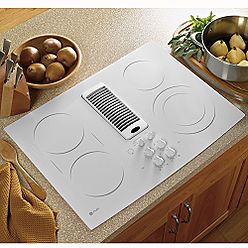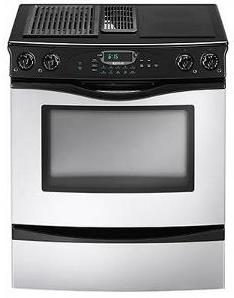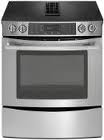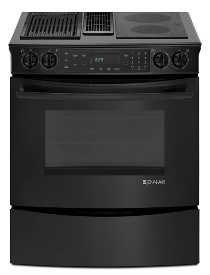Downdraft Electric
Range
Info and Buying
Guide For Downdraft Electric Ranges
Home | Downdraft Slide
In Electric Range | Jenn Air
Downdraft | Downdraft
Ventilation
Downdraft Electric
Cooktop | Downdraft Oven
| Downdraft Electric
Ranges
 
 
Downdraft Electric CooktopDowndraft electric cooktops are the last word in kitchen design choice and flexibility. Adding to the benefits of downdraft range technology, the downdraft electric cooktop fills another important need in modern kitchens. By unbundling the different major components of a traditional range--cooktop, oven and storage--it frees up kitchen design even further, making it possible to situate the cooktop in almost any convenient location while the oven can be installed in a wall, for example, at a height that does not require bending as a tradional range would. This is in fact becoming a more popular option in today's kitchens, with convenience, safety and health benefits overriding the extra cost. The downdraft ventilation mechanism of these electric downdraft cooktops are virtually the same as their range cousins and they will need venting installed either in the cabinetry below them and out through the floor to the outside or in an adjacent wall. Even though these cooktops don't need an overhead exhaust hood, many homeowners will install one anyway for a variety of reasons ranging from redundant air-cleaning and future flexibility to just a preference for the look. Cooktop sizesCook tops range in sizes from very compact 1-burner or 2-burner 15-inch to 20-inch models to very large 6-burner 48-inch models. A typical electric cooktop would have four burners, each of which would have a variable power control of 1,000 to 2,500 watts. Some more expensive and larger models may have more burners and a higher range of power, going upto 3,500 watts in some models. As a rule, the more coils a burner has, the faster it heats up. While choosing the right size, cooking surface alone may not be as important as the number and sizes of cookware that need to be accommodated on a cooktop.Conventional electric cooktopThe conventional downdraft electric cooktop comes in two basic styles--one with the standard exposed burner coils that we are likely most familiar with and the other with a smooth ceramic glass top. Each has its own benefits and drawbacks:
Induction electric cooktopThis is the latest technology in cooking appliances and uses electromagnetic energy to heat cookware directly rather than transfer heat to cookware via a heated cooktop surface. As a result, very little heat is wasted by radiation and this makes it far more energy efficient than conventional cooktops. It is also safer since the cook tops themselves don't get very hot. Finally, since all of the heat energy is focused on the cookware, the food gets cooked faster. With all these significant benefits however, comes a fairly significant drawback--induction cooking needs steel or cast iron cookware to work and will not work with common cookware materials like aluminum and copper. In order to mitigate this drawback somewhat, a hybrid type of cooktop is also being marketed now which combines the coil and induction technologies beneath a smooth ceramic glass top. For those who have no issues with cookware material, induction cook tops are a very serious option for an downdraft electric range or cooktop buyer.The downdraft electric cooktop offers the greatest amount of flexibility in design that a modern homeowner could want and the benefits should easily justify the costs. |
Sponsored Links
Downdraft Electric Range | About Us | Privacy Policy | Disclaimer | Contact Us | Site Map
Copyright 2011. All Rights Reserved
www.DowndraftElectricRange.com
DowndraftElectricRange.com is a participant in the
Amazon Services LLC Associates Program, an affiliate advertising program
designed to provide a means for sites to earn advertising fees by advertising and linking to
Amazon.com.